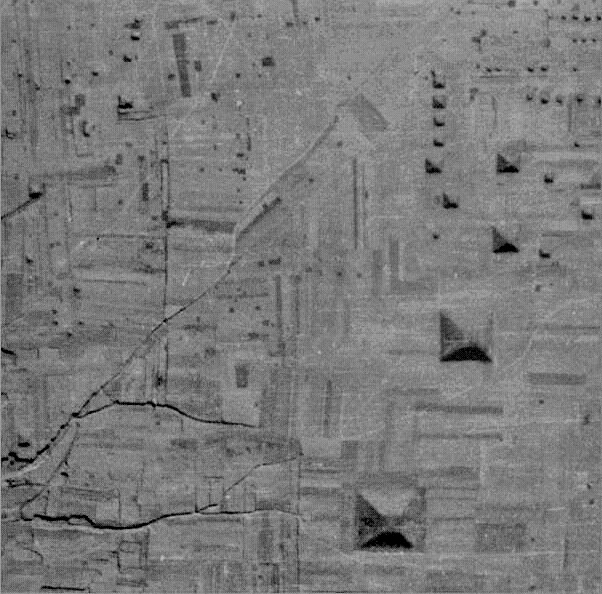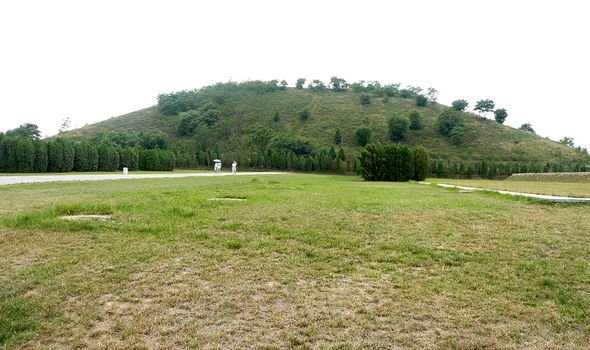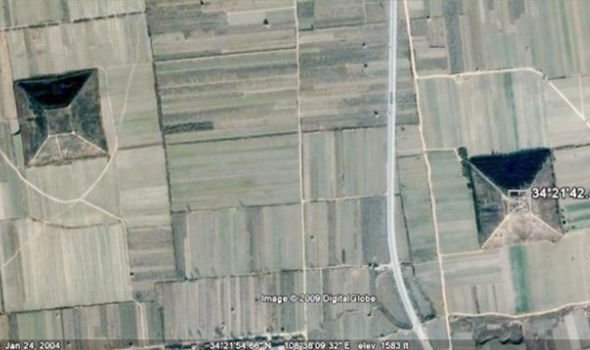THE CHINESE PYRAMIDS: BIGGER THAN THE EGYPTIAN ONES

Nestled in the loess plateau of China’s Shaanxi Province lies a cluster of pyramids that has captivated archaeologists and historians alike: the so-called Chinese pyramids. While the Great Pyramids of Giza often steal the spotlight, these lesser-known structures raise intriguing questions about ancient civilizations and their architectural prowess. They also hint at a potential global connection among ancient societies that constructed megalithic pyramids across various continents.
The most prominent of the Chinese pyramids is the so-called “The Tomb of the General,” often referred to as the “Chinese Pyramid.” Standing at around 300 feet high, it dwarfs its Egyptian counterparts in terms of sheer volume, yet it remains shrouded in mystery. Lacking the same level of excavation and scholarly attention, these pyramids are often overshadowed by more well-known sites.
A Global Civilization?
The notion of a global civilization that constructed megalithic structures across continents is both thrilling and controversial. From the pyramids of Egypt and China to the ziggurats of Mesopotamia and the step pyramids of the Americas, the presence of similar architectural forms leads some researchers to ponder whether these cultures were aware of one another or shared a common ancestral knowledge.
Evidence of Global Connections
While hard evidence remains elusive, some proponents of this theory point to the following:
- Trade Routes: Ancient trade routes may have facilitated the exchange of ideas, materials, and technologies.
- Astronomical Alignments: Many pyramids around the world exhibit alignment with celestial bodies, suggesting a shared astronomical understanding.
- Cultural Exchange: Myths and legends often contain parallels across cultures, hinting at a shared heritage or experience.
China’s Hidden Pyramids: Ancient Mysteries Guarded by Time and Tradition
In 1945, U.S. Air Force pilot James Gaussman flew over the heart of China, connecting India and China by air. What he saw from his cockpit became the stuff of legend. Amid the vast plains, a glimmer caught his eye: a colossal, white pyramid with a jewel-like capstone that sparkled in the sun. “It was pure white on all sides,” Gaussman later described, “The capstone was like a huge piece of crystal.” The sight struck him with awe, yet there was no chance to land and investigate further.
Just two years later, Colonel Maurice Sheahan, director for Trans World Airline, reportedly saw the same massive structure. His story even made The New York Times, captivating the public and sparking speculation about what could be one of the greatest archaeological discoveries in modern history. The real question, though, was whether the towering 1,000-foot structure was real—and, if so, what lay within its walls.
Fast-forward to today, and the answer has become clearer, albeit still shrouded in mystery. Thanks to satellite imagery, Google Earth now reveals evidence of around 40 ancient pyramid-like structures spread across Xi’an in Shaanxi Province. Though they’re not precisely pyramids as we know them from Egypt, they resemble enormous burial mounds with flat tops and gently sloping sides. Many of these earth-covered mounds date back as far as 8,000 years, remnants of an ancient Chinese tradition of building tombs for royalty. The site rivals Egypt’s Valley of the Kings, as beneath these hills lie centuries of untold royal history.
But what about the “White Pyramid” that Gaussman and Sheahan claimed to have seen? Despite several expeditions, including one by German investigator Hartwig Hausdorf in the early 1990s, no evidence has confirmed the existence of a towering, gleaming structure. Hausdorf noted that the area was heavily patrolled by the Chinese military, adding to the sense of secrecy and mystery around these ancient sites.

Other Witnesses
Interestingly, historical mentions of these structures date back much further. In the 17th century, a Roman Jesuit wrote about the pyramids, and in 1785, French orientalist Joseph de Guignes theorized that the Chinese people might have descended from Egyptians, citing the similarities in pyramids, scientific knowledge, and even reverence for tradition. While we now know there’s no direct connection between the two cultures, de Guignes’ fascination with these ancient monuments hinted at their significance.
Despite modern technology and archaeology, the Chinese pyramids remain largely unexplored. Covered in dense greenery, including fast-growing cypress trees, the tombs are meticulously maintained but left undisturbed. Many believe this overgrowth is intentional, shielding the structures from the elements and perhaps from prying eyes as well. Western archaeologists have had limited access, as the Chinese government has been cautious about permitting excavations. According to some officials, the technology to preserve and study the fragile artifacts within has yet to be perfected. Archaeologist Kristin Romey echoes this sentiment, noting how much information was lost during King Tutankhamun’s excavation in the 1920s due to the era’s rudimentary techniques. She argues that patience might yield far greater insights when the technology improves in the future.
There’s another possible explanation for China’s protective approach: a deep cultural reverence for tradition and for ancestors. This respect may be why Chinese authorities are content to leave the ancient royals resting in peace, even as curiosity mounts globally. This reverence for the past is embedded in Chinese culture, suggesting that the secrets of these rulers may remain buried for generations to come.
While some skeptics still question whether the mysterious White Pyramid ever existed, the ancient mounds of Xi’an hold their secrets tightly. Though tourism has opened to sites like the Han Yang Ling Mausoleum, which grants a glimpse into ancient Chinese burial practices, the central pyramids remain off-limits for excavation. Perhaps someday, when technology allows, we may uncover the long-lost emperors and treasures believed to lie beneath Xi’an. Until then, these enigmatic tombs will continue to fade back into the earth, carrying their secrets with them.

